Micro-algae transform carbon dioxide (CO2) and nutrients dissolved in the ocean into organic matter and oxygen. This process, photosynthesis, uses sunlight energy. These primary producers then become an energy source for a vital link in the marine food chain, that being herbivorous zooplankton.
A primary link in the trophic chain
Zooplankton are animals that live in suspension in the water column and drift with the currents. They differ from nekton, aquatic animals that actively swim, against currents, mainly fish and marine mammals. These plankton feed on living or decaying matter, and can be herbivorous or carnivorous. They are a vital link in the trophic chain because they channel the energy from the organic matter produced by phytoplankton to higher trophic levels. Small crustaceans of the class copepods, which comprise the vast majority of herbivorous zooplankton, graze on microalgae and are often compared to terrestrial ruminants. Zooplankton are the principal food source for pelagic fish and a number of benthic species, either during their larval or adult state. Some birds and whales feed exclusively on zooplankton.

An essential role in the carbon cycle
Another very important aspect of the influence of zooplankton in the phytoplankton spring bloom is their key role in the carbon cycle, particularly in the flux towards the sediments on the ocean floor . Microalgae fix CO2 and convert it into organic carbon through photosynthesis. A significant portion of this carbon remains in the surface layers of the ocean and ultimately ends up being consumed by marine bacteria, which release CO2 to the atmosphere by respiration. Through consumption of this carbon, herbivorous zooplankton produce a multitude of particles types (fecal pellets, mucus and exo-polymers, …) that are grouped under the term marine snow, and which rapidly settle to the bottom, therefore sequestering CO2 in ocean floor sediments. Zooplankton consequently have a positive impact on reducing the effect of greenhouse gases in the atmosphere.
For these reasons and many others, it is important to study the zooplankton population and monitor its development around the phytoplankton spring bloom. There are several ways of doing this. One of the oldest and most effective sampling instruments is the plankton net.
Sampling with a plankton net
To study the mesozooplankton, zooplankton from 0.2 to 20 mm in size, we use a circular metal frame, 1m in diameter, on which is attached a 4m long, 200 μm mesh nylon net. At the end of this filtering funnel, we attach a PVC pipe with holes covered in netting, which we call a cod-end. We also install a small 50 micron net on the outside of the frame, to harvest eggs and zooplankton larvae smaller than 200 microns. To ensure that the net sinks properly in the water column without tangling, the cod-ends are attached to a weight connected to the circular frame by 3 cables. In addition, we install a flowmeter in the net opening, which allows us to estimate the volume of water filtered during sampling and consequently, the abundance of zooplankton per liter or cubic meter. This net is attached to the winch cable and is lowered into a hole in the ice to a depth of 350 m (approximately 10 m above the ocean floor). The net is then raised at a constant speed through the water column, capturing zooplankton. Once the net is bought to the surface, we retrieve the filtered animals that were collected in the cod-ends. They are preserved in formalin solution and subsequently analyzed in our laboratory at Université Laval in Quebec City, where the relevant abundances of the different species are determined.
One of the particularities of zooplankton sampling at the GreenEdge ice camp site, which fascinates everybody, is the presence of a significant bioluminescence in the fresh samples. This blue-green bioluminescence is produced by a copepod species from the Calanoid order: Metridia longa.
Text and voice: Cyril Aubry
Video: Christiane Dufresne

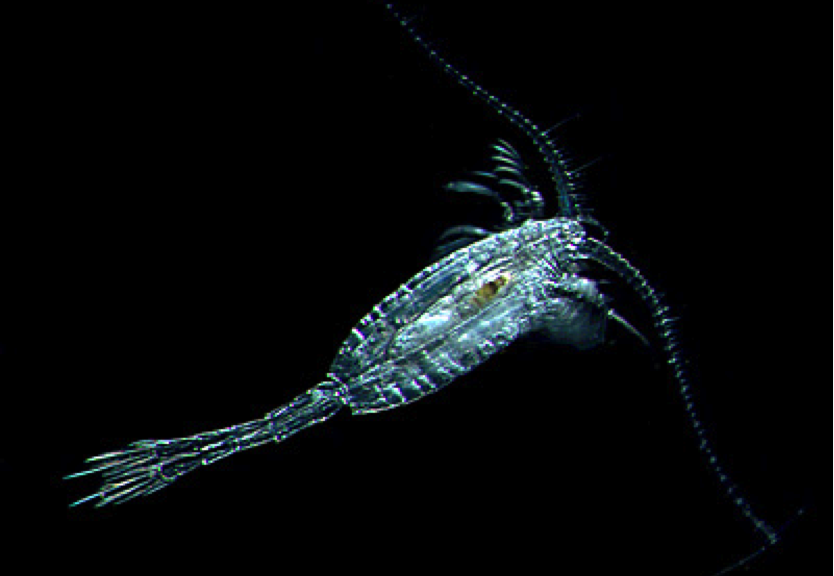
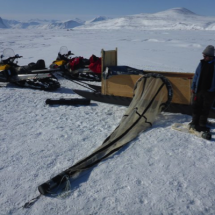

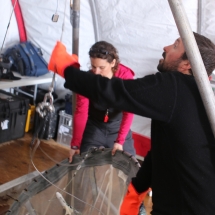
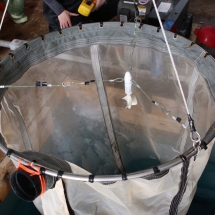

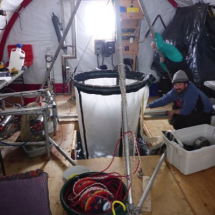
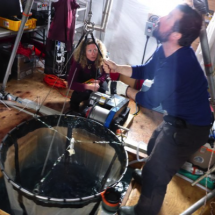

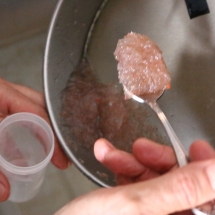
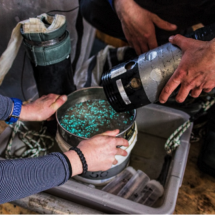
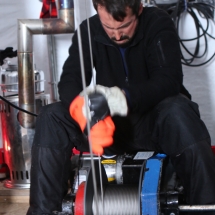


One thought on “Catching a luminescent animal”